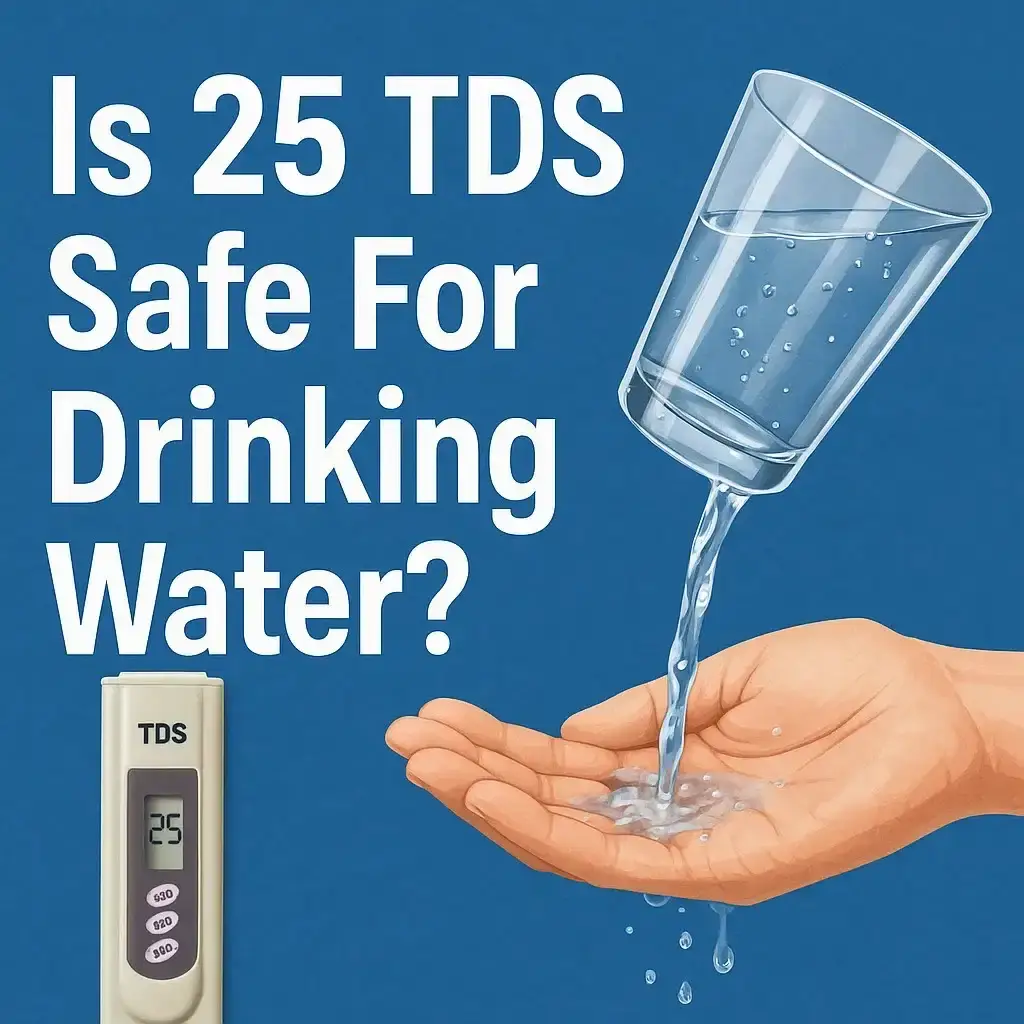share
TRENDING
Is 25 TDS Safe for Drinking Water?
Oct. 7, 2025
407 Views
If you use an RO water purifier, you've likely seen a very low TDS reading—sometimes as low as 25 ppm—and asked the critical question: Is 25 TDS safe for drinking water?
The short answer is yes, it is safe for short-term consumption, but it is not recommended for long-term daily use due to a lack of essential minerals.
This comprehensive guide will break down exactly what a 25 TDS level means for your health, based on WHO and BIS standards. We’ll explore the pros, cons, and how to achieve the ideal TDS level for your family.
What Does a 25 TDS Level Actually Mean?
TDS (Total Dissolved Solids) measures the total concentration of dissolved substances in water, expressed in parts per million (ppm). These substances include:
-
Beneficial Minerals: Calcium, magnesium, potassium.
-
Salts: Bicarbonates, chlorides, sulfates.
-
Potential Contaminants: Heavy metals, nitrates, and other impurities.
👉 The Key Insight: A TDS meter only gives you a number, not a breakdown. Water with 25 ppm of harmless salts is safe, but water with 25 ppm of lead is dangerous. Since RO systems effectively remove contaminants, a reading of 25 TDS in RO water generally indicates very pure water that is also devoid of minerals.
What Do WHO and BIS Say About 25 TDS Water?
Official guidelines help us put the number "25" into perspective.
WHO Guidelines on TDS
According to the WHO, 25 TDS water is classified as "Very Low." It is considered safe from a contamination standpoint but is not ideal due to its flat taste and lack of minerals.
BIS (Bureau of Indian Standards) Standards
-
Minimum Desirable TDS: 50 ppm
-
Acceptable Range: 50 – 300 ppm
-
Maximum Permissible Limit: 500 ppm (in absence of a better source)
BIS explicitly states that water with a TDS below 50 ppm is not desirable for long-term consumption. This directly answers our question: while 25 TDS is safe, it falls below the recommended minimum for optimal health.
The Pros and Cons of Drinking 25 TDS Water
Here’s a quick breakdown of what 25 ppm water means for you:
Health Implications of Long-Term 25 TDS Consumption
Drinking 25 TDS water for years is unlikely to cause immediate harm, but it may have subtle long-term effects:
-
Mineral Deficiency: If your diet is not rich in minerals, relying solely on demineralized water could contribute to deficiencies in calcium and magnesium, important for bone and heart health.
-
Electrolyte Imbalance: Ultra-pure water may dilute electrolytes in the body, a particular concern for athletes or those in hot climates.
-
Potential Corrosivity: Low-TDS water can be slightly acidic and may leach metals from pipes and storage tanks.
How to Fix Low TDS in RO Water (From 25 to Ideal)
The ideal TDS for drinking water is between 50-150 ppm. If your RO output is 25 ppm, here’s how to increase it safely:
-
Install a TDS Controller (or Mineralizer): This is the best solution. It either mixes a small amount of mineral-rich water back into the purified stream or adds beneficial minerals like calcium and magnesium through a special cartridge.
-
Manually Mix Water: You can blend your 25 TDS RO water with a small amount of safe, filtered tap water or mineral water to raise the TDS level.
-
Choose the Right Purifier: If your input water TDS is already below 300 ppm, a UV+UF purifier might be a better choice than an RO system, as it preserves natural minerals.
FAQ: Is 25 TDS Safe for Drinking Water?
Q1: Is 25 TDS water safe for babies and children?
While safe, it is not optimal. Children need minerals like calcium and magnesium for development. It's better to provide water in the 50-150 ppm range.
Q2: Can I drink 25 TDS water every day?
You can, but it is not advisable for long-term health. For daily hydration, water with some minerals is superior.
Q3: What is the healthiest TDS level for drinking water?
Most health authorities, including WHO, suggest that water with a TDS between 50-150 ppm offers the best balance of purity, taste, and health benefits.
Q4: Why does my 25 TDS water taste bad?
Ultra-low TDS water tastes "flat" or "lifeless" because the minerals that give water its refreshing taste have been removed.
Conclusion:
Is 25 TDS Safe for Drinking Water?
Yes, 25 TDS water is safe to drink as it is free from harmful contaminants. However, it is not the healthiest choice for long-term, daily consumption because it lacks beneficial minerals.
The Bottom Line: For optimal health, aim for a TDS level between 50-150 ppm. If your RO system produces 25 TDS water, investing in a simple TDS controller or mineralizer cartridge is a highly recommended upgrade to ensure your water is both safe and nutritious.
Also Know:
share Share now









